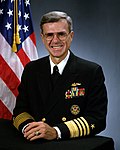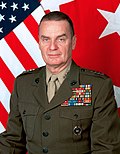| No. | Senior Military Assistant | Term | Service branch | Secretary of Defense | Ref. |
|---|
| Portrait | Name | Took office | Left office | Term length |
|---|
| 1 |  | Major General
Colin Powell | July 1983 | June 1986 | ~2 years, 335 days | 
U.S. Army | Caspar Weinberger | - |
| 2 |  | Vice Admiral
Donald S. Jones | June 1986 | January 1987 | ~214 days | 
U.S. Navy | Caspar Weinberger
Frank Carlucci | [2] |
| 3 |  | Major General
Gordon E. Fornell | January 1987 | September 1988 | ~1 year, 244 days | 
U.S. Air Force | Frank Carlucci | [3] |
| 4 |  | Rear Admiral (lower half)
William Owens | July 1988 | August 1990 | ~2 years, 31 days | 
U.S. Navy | Frank Carlucci
Dick Cheney | [4] |
| 5 |  | Rear Admiral (lower half)
Thomas J. Lopez | August 1990 | May 1992 | ~1 year, 274 days | 
U.S. Navy | Dick Cheney | [5] |
| 6 |  | Major General
John P. Jumper | May 1992 | February 1994 | ~1 year, 276 days | 
U.S. Air Force | Les Aspin | [6] [7] |
| 7 |  | Major General
Paul J. Kern | March 1994 | June 1996 | ~2 years, 92 days | 
U.S. Army | William Perry | [8] [9] |
| 8 |  | Major General
Randolph W. House | June 1996 | January 1997 | ~214 days | 
U.S. Army | William Perry | [10] [11] [12] |
| 9 |  | Lieutenant General
James L. Jones | January 1997 | May 1999 | ~2 years, 120 days | 
U.S. Marine Corps | William Cohen | [13] [14] [15] |
| 10 |  | Vice Admiral
Gregory G. Johnson | May 1999 | October 2000 | ~1 year, 153 days | 
U.S. Navy | William Cohen | - |
| 11 |  | Rear Admiral (lower half)
Deborah Loewer | October 2000 | 2001 | ~258 days | 
U.S. Navy | William Cohen | - |
| 12 |  | Vice Admiral
Edmund P. Giambastiani | 2001 | August 2002 | ~1 year, 46 days | 
U.S. Navy | William Cohen
Donald Rumsfeld | - |
| 13 |  | Lieutenant General
Bantz J. Craddock | August 2002 | July 2004 | ~1 year, 335 days | 
U.S. Army | Donald Rumsfeld | - |
| 14 |  | Vice Admiral
James G. Stavridis | July 2004 | August 2006 | ~2 years, 31 days | 
U.S. Navy | Donald Rumsfeld | - |
| 15 |  | Lieutenant General
Victor E. Renuart Jr. | August 2006 | February 2007 | ~184 days | 
U.S. Air Force | Robert Gates | [16] |
| 16 |  | Lieutenant General
Peter W. Chiarelli | March 2007 | August 2008 | ~1 year, 153 days | 
U.S. Army | Robert Gates | - |
| 17 |  | Lieutenant General
David M. Rodriguez | August 2008 | June 2009 | ~304 days | 
U.S. Army | Robert Gates | - |
| 18 |  | Vice Admiral
Joseph D. Kernan | June 2009 | April 2011 | ~1 year, 304 days | 
U.S. Navy | Robert Gates | - |
| 19 |  | Lieutenant General
John F. Kelly | April 2011 | August 2012 | ~1 year, 122 days | 
U.S. Marine Corps | Robert Gates
Leon Panetta | - |
| 20 |  | Lieutenant General
Thomas D. Waldhauser | August 2012 | September 2013 | ~1 year, 31 days | 
U.S. Marine Corps | Leon Panetta
Chuck Hagel | - |
| 21 |  | Lieutenant General
Robert B. Abrams | September 2013 | 24 June 2015 | ~1 year, 282 days | 
U.S. Army | Chuck Hagel
Ash Carter | - |
| 22 |  | Lieutenant General
Ronald F. Lewis | 24 June 2015 | 12 November 2015 | 141 days | 
U.S. Army | Ash Carter | [17] [18] |
| 23 |  | Brigadier General
Eric Smith | ~7 January 2016 | ~23 June 2017 | ~1 year, 167 days | 
U.S. Marine Corps | Ash Carter
Jim Mattis | [19] [20] |
| 24 |  | Vice Admiral
Craig S. Faller | ~23 June 2017 | ~1 September 2018 | ~1 year, 70 days | 
U.S. Navy | Jim Mattis | [21] |
| 25 |  | Lieutenant General
George W. Smith Jr. | 1 September 2018 | 12 August 2019 | 345 days | 
U.S. Marine Corps | Jim Mattis
Mark Esper | [22] |
| 26 |  | Lieutenant General
Bryan P. Fenton | 12 August 2019 | 3 June 2021 | 1 year, 295 days | 
U.S. Army | Mark Esper
Lloyd Austin | [23] |
| 27 |  | Lieutenant General
Randy George | 3 June 2021 | ~7 July 2022 | 1 year, 34 days | 
U.S. Army | Lloyd Austin | [24] |
| 28 |  | Lieutenant General
Ronald P. Clark | ~7 July 2022 | 1 October 2024 | 2 years, 86 days | 
U.S. Army | Lloyd Austin | [25] |
| 29 |  | Lieutenant General
Jennifer Short | 1 October 2024 | 22 February 2025 [26] | 144 days | 
U.S. Air Force | Lloyd Austin
Pete Hegseth | [27] |
| 30 |  | Lieutenant General
Christopher LaNeve | 7 April 2025 | Incumbent | 246 days | 
U.S. Army | Pete Hegseth | |



































